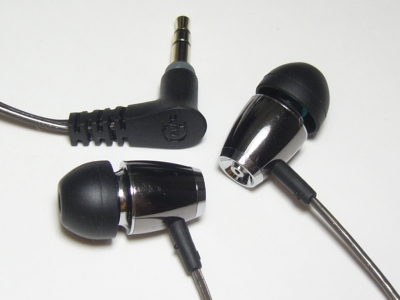Details: Vented, vocal-oriented earphone from Dunu
MSRP: est. $76 (manufacturer’s page)
Current Price: $70 from amazon.com / $70 from ebay.com
Specs: Driver: Dynamic | Imp: 16Ω | Sens: 102 dB | Freq: 16-22k Hz | Cable: 4′ L-plug
Nozzle Size: 3.5mm | Preferred tips: Sony Hybrid-style single-flange (stock)
Wear Style: Straight down or over-the-ear
Accessories (5/5) – Single-flange (3 sizes), bi-flange, and Sony Hybrid-style (4 pairs in 3 sizes) silicone tips, airline adapter, ¼” adapter, shirt clip, cleaning cloth, soft pleather carrying pouch, crushproof metal carrying case, and integrated cable wrap
Build Quality (4.5/5) – The new Dunu earphones continue to amaze with their build quality – solid metal housings boast excellent fit and finish and the new silver cables are terminated by a heavy-duty L-plug. Proper strain relief is present all around. The cable itself is softer and more supple than previous cords but the sheath is somewhat sticky and tangle-prone
Isolation (3/5) – Good for a vented dynamic-driver earphone
Microphonics (3.5/5) – Bothersome when worn cable-down; not an issue otherwise
Comfort (3.5/5) – The housings are moderately large and on the heavy side. Nozzles are stepped to allow for a deeper insertion but the front edges are wide, sharp, and potentially problematic for those with smaller ears
Sound (6.8/10) – The DN-17 Crater is a vented earphone tuned specifically for vocal performances. It is not surprising, then, that it is the least bass-dominant of all the Dunu models I’ve tried. The low end of the Crater offers good depth and punch, lagging slightly behind sets such as the DN-16 Hephaes, DN-12 Trident, and Brainwavz M2 in overall bass quantity. It is about as controlled as that of the cheaper Trident, sounding a bit bloated at times, but has a slightly more linear curve with less mid-bass emphasis. Note presentation is slightly on the soft side, resulting in a slight lack of crispness and resolution. There is some texture missing as well, giving the bass a somewhat ‘hollow’ feel with more impact than information.
The midrange of the Crater is prominent and very full-bodied. The balance and presentation are very different from most competing sets – the Crater can easily be called mid-centric despite the ample bass punch and vocals are always upfront, as advertised. Nearly any other earphone sounds thinner in comparison. As with the bass, texture and detail levels are mediocre and the sound has a dull nature, partly due to the underemphasized treble. Indeed, the Crater altogether lacks the increased clarity attained as a result of treble emphasis, relying entirely on natural clarity for intelligibility. The results of not having a very dark background are mixed, sounding excellent on vocal-centric tracks but reverting to an ‘AM radio’ feel with genres relying on heavy instrumentation.
The top end of the Crater is dull and lacks emphasis compared even to the similarly-priced DN-16 Hephaes. Treble extension isn’t bad but detail levels are only on-par with the cheaper DN-12 Trident and there isn’t much crispness or sparkle to the top end. Harshness and sibilance are absent but the treble clearly take a back seat, resulting in a distinct lack of energy. Despite this the Crater has good air that compliments its full, fluid sound well.
The presentation of the Crater is generally forward, especially in the midrange, but the softer note character prevents it from sounding aggressive. The headstage is larger than average and while the positioning is on the vague side, the Crater never sounds congested. Compared to the Dunu Hephaes, the Crater sounds large and full, more of an ‘in-ear speaker’ to the Hephaes’ ‘in-ear earphone’. Interestingly, the Crater is also more sensitive than the previous Dunu dynamics and has a tendency to pick up electrical noise.
Updated January 2013 (7.2/10)
An updated version of the Crater has replaced the one I originally reviewed, boasting the same design with improved sound tuning. The new tuning is a major step forward, in essence applying a v-shaped filter over the somewhat mid-centric sound of the original Crater. The resulting sound very different from the original – dynamic and engaging in ways that make the old tuning seem dull and muffled.
The bass, for one, no longer sounds sluggish and uninformative; instead, it is punchy and dynamic, with better extension compared to the original Crater. The overall sound is more balanced and less mid-centric. Clarity is improved and vocals boast better intelligibility despite the lack of midrange emphasis. Added treble presence creates more natural treble energy for a more realistic sound. The less relaxed top end does cause the new Crater to sound less smooth and forgiving, but the slight increase in the potential for sibilance is a worthy tradeoff.
The presentation is where the biggest gains are made – the new Crater is more dynamic and has better soundstage depth and layering. The presentation is now very good overall – broad, yet boasting decent imaging. All in all, the new Crater is notably more competitive when it comes to audio quality – unquestionably an all-around improvement that justifies the price tag.
Value (8/10) – The DN-17 Crater carries on Dunu’s trend of offering unparalleled build quality and attention to detail at a low price, but does so with a new, more restrained design. While the original tuning was best suited for those who usually listen with a ‘vocal’ EQ preset applied, the new (as of late 2012) tuning makes the Crater easy to recommend over its DN-18 Hawkeye counterpart.
Pros: Very well-built and well-accessorized; full and spacious sound
Cons: Cable can be noisy when worn straight down



